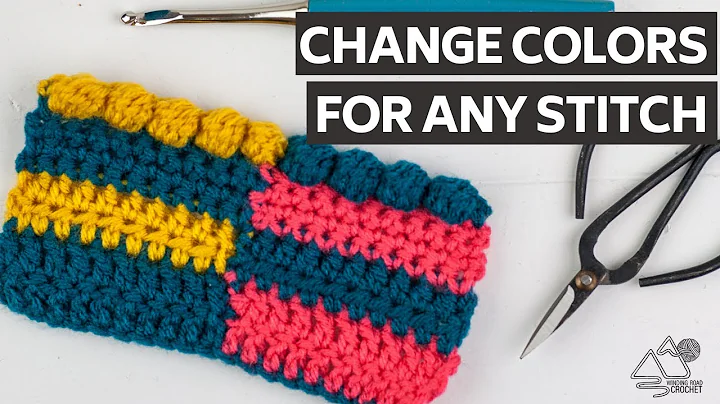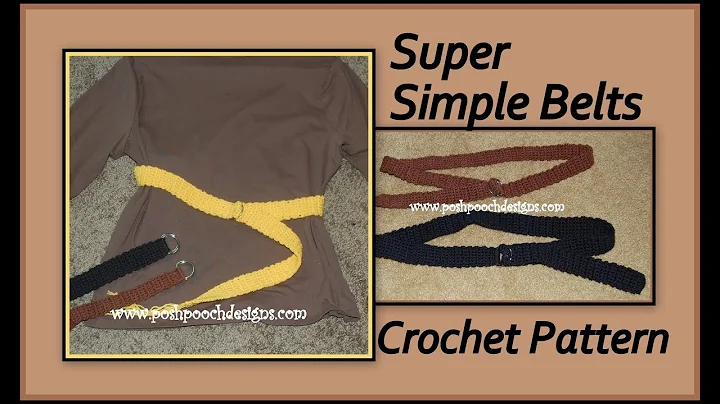Unleash Your Crochet Skills: Crochet 2 Rows Simultaneously!
Table of Contents:
- Introduction
- Creating the Slipknot
- Making the Initial Chain
- Adding Additional Chains
- Working the First Treble Crochet
- Continuing the Treble Crochet Pattern
- Completing Rows 3 and 4
- Repeating the Pattern
- Tips for a Straight Edge
- Conclusion
Making a Treble Crochet Stitch: A Step-by-Step Guide
Introduction:
Crocheting is a popular and enjoyable craft that allows you to create beautiful and unique projects. One commonly used stitch in crochet is the treble crochet stitch, also known as the double crochet stitch in the US. In this article, we will guide you through the process of making a treble crochet stitch, from creating the slipknot to completing rows of the stitch pattern. By following these step-by-step instructions, you'll be able to incorporate the treble crochet stitch into your own crochet projects with ease.
Creating the Slipknot:
To begin your crochet project, you'll first need to create a slipknot. This is the starting point for your yarn and will secure it to your crochet hook. There are various methods you can use to create a slipknot, so choose the one that you find most comfortable and easy to work with.
Making the Initial Chain:
Once you have created your slipknot, you'll need to make the initial chain. The width of your chain will depend on the size of your project. To make the chain, you'll yarn over and pull through the loop on your hook, repeating this process until the chain is as wide as you desire. Whether you're making a scarf, a blanket, or any other project, ensure that the chain matches the desired width.
Adding Additional Chains:
After creating the initial chain, you may need to add additional chains to help create the desired pattern. Yarn over and pull through for each additional chain, making sure to count the number of chains accurately. These additional chains will assist in creating the treble crochet pattern.
Working the First Treble Crochet:
To begin the treble crochet pattern, you'll need to work into the third chain from the hook. Yarn over and insert your hook into the specified chain, then yarn over again without pulling through. Skip the next two stitches and work into the third chain from the last stitch. Continue the process of yarning over, pulling through, and yarning over again until you have five loops on your hook. Finally, yarn over and pull through the first two loops, then repeat this step until only two loops remain on your hook.
Continuing the Treble Crochet Pattern:
As you work along the chain, you'll notice two posts created by the treble crochet stitches. These posts separate each stitch diagonally. To continue the treble crochet pattern, you'll need to work into the shorter post, skipping the longer one. Yarn over and insert your hook behind the shorter post, then yarn over and pull through. Repeat this process until you reach the end of the chain, regularly yarn over, pull through, and repeat until only two loops remain on your hook.
Completing Rows 3 and 4:
After completing the first row, you'll need to begin rows 3 and 4. Start by chaining five, then turn your work. Yarn over and insert your hook into the third chain from the hook, then work into the first stitch. Repeat the treble crochet process, working into the shorter diagonal posts until you reach the end of the row. Continue repeating these steps for both rows 3 and 4.
Repeating the Pattern:
To continue building up your crochet project, repeat the pattern established in rows 3 and 4. Chain five, turn your work, and repeat the treble crochet process. This repetition will create a consistent stitch pattern and build up your project quickly.
Tips for a Straight Edge:
To maintain a straight edge while working with the treble crochet stitch, it's crucial to work into the last stitch of each row and avoid working into the base of the very first stitch. By following this rule, you'll achieve cleaner edges and a more polished final result.
Conclusion:
The treble crochet stitch is a versatile and popular crochet stitch that can be used in a variety of projects. With the step-by-step instructions provided in this article, you'll be able to create beautiful and intricate patterns using the treble crochet stitch. Remember to practice and experiment with different variations to add your own unique touch to your crochet projects. Happy crocheting!
Highlights:
- Learn how to create a slipknot and make the initial chain for your crochet project.
- Add additional chains to create the desired width and assist in the treble crochet pattern.
- Work the first treble crochet stitch by skipping stitches and creating loops on your hook.
- Continue the treble crochet pattern by working into the shorter diagonal posts of each stitch.
- Complete rows 3 and 4 by repeating the treble crochet process.
- Repeat the pattern to build up your project quickly.
- Maintain a straight edge by working into the last stitch of each row and avoiding the base of the first stitch.
- Practice and experiment with different variations to add your own personal touch to your crochet projects.
FAQ:
Q: What is a treble crochet stitch?
A: A treble crochet stitch, also known as a double crochet stitch in the US, is a common crochet stitch used to create tall and open stitches in crochet projects.
Q: How do I create a slipknot?
A: To create a slipknot, make a loop with your yarn, insert your crochet hook through the loop, and pull the working end of the yarn to tighten the knot. Adjust the size of the loop as needed.
Q: How many chains do I need for my project?
A: The number of chains needed for your project depends on the desired width. Make sure to chain the appropriate number of stitches to match the width of your project.
Q: Can I use the treble crochet stitch for different projects?
A: Yes, the treble crochet stitch can be used in various projects such as scarves, blankets, garments, and home decor items. Experiment with different yarns and hook sizes to achieve different effects.
Q: How can I ensure straight edges in my treble crochet project?
A: To maintain straight edges, make sure to work into the last stitch of each row and avoid working into the base of the first stitch. This will help create cleaner and more polished edges.
 WHY YOU SHOULD CHOOSE BEAUTYBADY
WHY YOU SHOULD CHOOSE BEAUTYBADY







